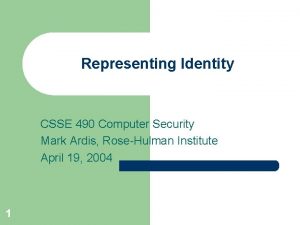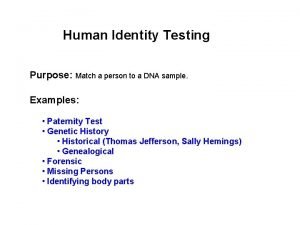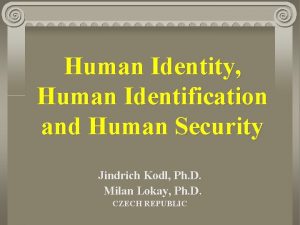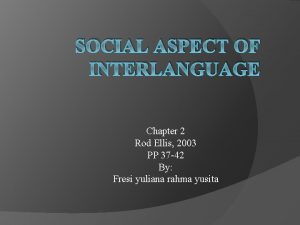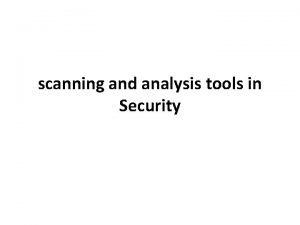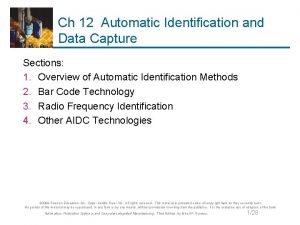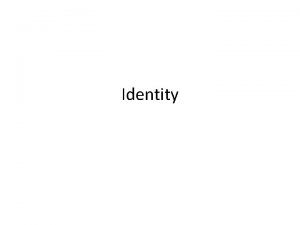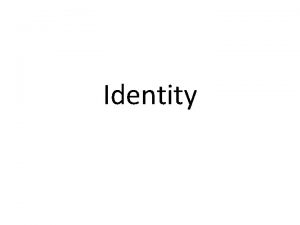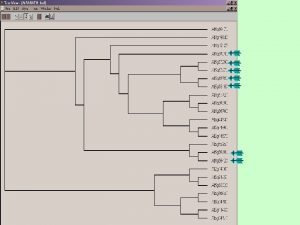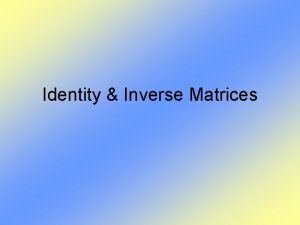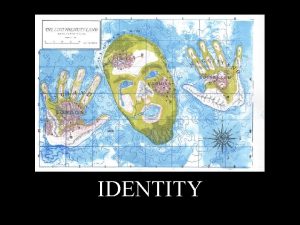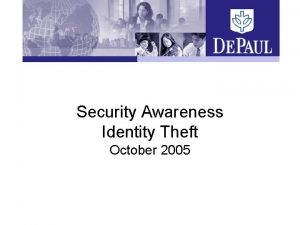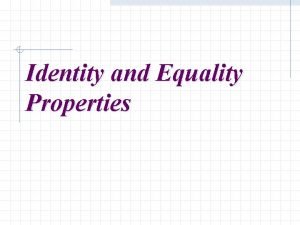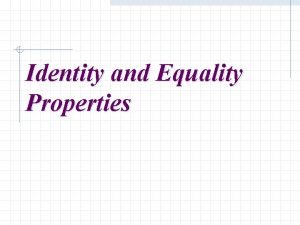Human Identity Human Identification and Human Security Jindrich































- Slides: 31

Human Identity, Human Identification and Human Security Jindrich Kodl, Ph. D. Milan Lokay, Ph. D. CZECH REPUBLIC

ABSTRACT Many information systems involve data about people. This presentation seeks to overcome that deficiency, by undertaking a survey of human identity, human identification and human security. The techniques discussed include names, codes, knowledge-based and token-based id, and biometrics.

KEYWORDS Identity, Identification, Security, Biometrics, Identification Bases and Schemes, Personal Identification Number.

INTRODUCTION The presentation focuses on the identification of human individuals. The following related matters illustrates this area, but are not the focal point of discussion: the identification of products and packaging; the identification of vehicles; the identification of animals;

INTRODUCTION forms of identification which show a category to which a person belongs, rather than specifying the individual;

HUMAN IDENTITY From our point of view, identity is used to mean "the condition of being a specified person", or "the condition of being oneself. . . and not another". It clusters with the terms 'personality', 'individuality' and 'individualism', and, less fashionably, 'soul'.

HUMAN IDENTIFICATION The term 'identification' means the act or process of "establishing the identity of, [or] recognising", "the treating of a thing as identical with another" "the act [or process] of recognising or establishing as being a particular person", but also "the act [or process] of making, representing to be, or regarding or treating as the same or identical".

HUMAN IDENTIFICATION In the context of information systems, the purpose of identification is more concrete: it is used to link a stream of data with a person. This presentation adopts as its operational definition: human identification is the association of data with a particular human being

HUMAN IDENTIFICATION All identification mechanisms are fraught with difficulties, and hence the vast majority of transactions involve risk. They also cost money.

ORGANISATIONAL NEEDS FORMAL IDENTIFICATION Identity and identification are vague and ambiguous. They continue to be treated with considerable looseness by most legal systems. For social purposes, informal, contextual identification is sufficient. There also many circumstances in which informal identification, or even none at all, suffices for economic transactions

ORGANISATIONAL NEEDS FORMAL IDENTIFICATION When, for example, organisations have to have reliable identification of the individuals they deal with then have to ensure the protection of the individual. More commonly, the purpose is to protect the organisation

ORGANISATIONAL NEEDS FORMAL IDENTIFICATION The source of the issues discussed in this presenttion are the following questions: · when anonymity is unacceptable and identification necessary, · what circumstances the restriction of a person to a single identity is appropriate.

BASES FORMAL IDENTIFICATION A variety of means is available for identifying a person, in order to associate data with them. These include: appearance - or how the person looks; social behaviour - or how the person interacts with others; names - or what the person is called by other people; codes - or what the person is called by an organisation;

BASES FORMAL IDENTIFICATION knowledge - or what the person knows; tokens - or what the person has; bio-dynamics - or what the person does; natural physiography - or what the person is; and imposed physical characteristics - or what the person is now.

NAMES Over a period of centuries, the demand of using of surnames began to be necessary. For people who did not own land, the primary sources of surnames were: locality or territory; offices, and later occupations and trades; parentage, predominantly in the male; and nicknames.

CODES To cope with the vagaries of name-based identification, it is common for organisations to create coding schemes. These are commonly based on a set of digits, but may incorporate alphabetic characters.

KNOWLEDGE - BASED IDENTIFICATION Passwords are a very common application of knowledge-based identification. Another is the Personal Identification Number (PIN) used in conjunction with Automatic Teller Machines and merchants' EFT/POS terminals.

BIOMETRICS The term 'biometrics' is used to refer to any and all of a variety of identification techniques which are based on some physical and difficultto-alienate characteristic. They are sometimes referred to as 'positive identification', because they are claimed to provide greater confidence that the identification is accurate.

BIOMETRICS Hence biometric techniques involve 'metrics' or measurements of some kind, rather than depending merely on informal or subliminal methods. The natural physiological characteristics traditionally employed by the international passport system are fairly gross, and are seldom sufficient to reliably identify a person.

A TAXONOMY OF BIOMETRIC TECHNIQUES appearance social behaviour bio-dynamics natural physiography imposed physical characteristics

DESIRABLE CHARACTERISTICS OF A HUMAN IDENTIFIER universality of coverage - every relevant person should have an identifier uniqueness - each relevant person should have only one identifier - no two people should have the same identifier

DESIRABLE CHARACTERISTICS OF A HUMAN IDENTIFIER permanence - the identifier should not change, nor be changeable indispensability - the identifier should be one or more natural characteristics, which each person has and retains. If artificial, the identifier should be enforcedly available at all times

DESIRABLE CHARACTERISTICS OF A HUMAN IDENTIFIER collectibility - the identifier should be collectible by anyone on any occasion storability - the identifier should be storable in manual and in automated systems exclusivity - no other form of identification should be necessary or used

DESIRABLE CHARACTERISTICS OF A HUMAN IDENTIFIER precision - every identifier should be sufficiently different from every other identifier that mistakes are unlikely simplicity - recording and transmission should be easy and not error-prone

DESIRABLE CHARACTERISTICS OF A HUMAN IDENTIFIER cost - measuring and storing the identifier should not be unduly costly convenience - measuring and storing the identifier should not be unduly inconvenient or time-consuming acceptability - its use should conform to contemporary social standards

CURRENT DEVELOPMENTS During the last decade, the march of identification, data-processing and communication technologies have excited a particularly enthusiastic surge of attempts by governments to introduce general-purpose, national schemes.

PUBLIC POLICY ISSUES - INHERENT OBJECTIONS TO IDENTIFICATION All forms of identification may attract opposition in different circumstances. The greatest degree of public distrust, however, is generally associated with biometric identifiers. Their use is in some cases invasive, and in all cases seems that way.

PUBLIC POLICY ISSUES - INHERENT OBJECTIONS TO IDENTIFICATION As the sophistication of identification technologies increases, the identification schemes operated by individual corporations and government agencies require regulation, in order to achieve appropriate balance between personal, corporate and social needs.

RISKS IN MULTI - PURPOSE IDENTIFICATION SCHEMES Most people are cowed by the power of large institutions, and resent at least some aspects of the surveillance society. The imposition of social control mechanisms, including the enforced use of intrusive identification, could stimulate an increased degree of conscious nonacceptance of authority.

CONCLUSIONS Identification is an important design consideration in information systems, which deal with people. The more effective biometrics-based identification schemes all involve serious social implications, and can be expected to excite considerable public suspicion and even hostility.

CONCLUSIONS The highest-integrity schemes combine physically intrusive data-collection with a potentially ubiquitous instrument of power. As a result, the kinds of multi-purpose identification schemes, or inhabitant registration systems, which would appear capable of exciting the greatest degree of concern are those based on DNA-printing and implanted chips.
 Jindrich polak
Jindrich polak Jindřich kušnír
Jindřich kušnír Private security
Private security Presumptive identification vs positive identification
Presumptive identification vs positive identification Identity icebreaker
Identity icebreaker Mark ardis
Mark ardis Identity-driven security
Identity-driven security Identity driven security
Identity driven security Dissociative identity disorder social security disability
Dissociative identity disorder social security disability Wireless security in cryptography
Wireless security in cryptography Integrity in e commerce
Integrity in e commerce Osi security architecture with neat diagram
Osi security architecture with neat diagram Security guide to network security fundamentals
Security guide to network security fundamentals Visa international security model in information security
Visa international security model in information security Electronic mail security in network security
Electronic mail security in network security Cnss security model
Cnss security model Software security touchpoints
Software security touchpoints Security guide to network security fundamentals
Security guide to network security fundamentals Security guide to network security fundamentals
Security guide to network security fundamentals Human identity testing
Human identity testing Identity of a person
Identity of a person Role of amc
Role of amc Social aspects of interlanguage
Social aspects of interlanguage Stylistic continuum
Stylistic continuum Uncg erm
Uncg erm Feather identification
Feather identification Scope and objectives of research problem
Scope and objectives of research problem Hirarc assignment
Hirarc assignment Fish and shellfish identification chapter 34
Fish and shellfish identification chapter 34 Subject and verb identification
Subject and verb identification Identification of scanning and analysis tools
Identification of scanning and analysis tools Automatic identification and data capture pdf
Automatic identification and data capture pdf





